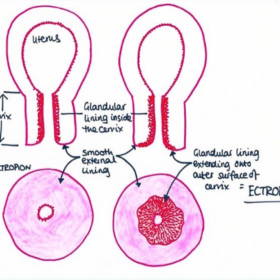
What does the colour of your discharge mean?
In this article
What's the lowdown?
Discharge is a collection of dead cells and bacteria from your vaginal canal
It generally is off-white, sticky and has a tangy smell to it
Infections can change the colour, consistency and smell of your discharge
What is vaginal discharge?
Have you ever wondered what that sticky white substance on your underwear is? Where has it come from? Why is it even there? Let’s get stuck in!
The vagina is a complex and wondrous organ, yes organ, that has a unique ecosystem of bacteria (vaginal microbiome) that keeps it in perfect acidic balance, around a pH of 4-4.51. It is, however, quite sensitive to changes, internal or external, causing unwanted symptoms like itching or unusual discharge.
The fluid made by our vaginal canal and cervix flushes out dead cells and bacteria, keeping your vagina clean. This is what you know as vaginal discharge2.
Vaginal discharge norms vary between people. Typically, you might notice around 1-4 ml of clear vaginal discharge every day. It should be transparent, a shade of white or yellow, with a slight acidic smell1.
Discharge colour meanings
White vaginal discharge
White creamy discharge that causes no symptoms if often normal and associated with changes in your menstrual cycle, or with hormonal contraception.
However, white vaginal discharge and itching usually go hand in hand and point towards thrush. You might have heard words like ‘cottage cheese’ or ‘cotton wool’ to describe your discharge. You could also feel itchiness and irritation around your vulva and vagina, and stinging when you have sex or pee. Thrush usually self-resolves or is easily treated with antifungal creams or pessaries3.
Grey vaginal discharge
Bacterial vaginosis is not an STI but a vaginal infection that produces thin grey vaginal discharge with a fishy smell. While not an STI, it is an infection and may need treatment either with gels to rebalance the vaginal bacteria, or with antibiotics4.
Green vaginal discharge
Trichomoniasis is a sexually transmitted infection (STI) that characteristically results in green-yellow discharge. It usually has a funky smell to it and you might notice a frothy or thick discharge consistency. Your vulva might become sore and itchy as well and this could spread to your inner thighs. Urinating and sex might become uncomfortable5.
Yellow vaginal discharge
Other STIs, like chlamydia and gonorrhoea, can result in yellow vaginal discharge. You might also feel tummy or pelvis pain, bleeding between your periods and a burning sensation while you pee6,7.
Brown vaginal discharge
Most commonly, brown vaginal discharge is a result of old period blood finally making its way out of the vaginal canal and staining your discharge brown. However, if you notice brown vaginal discharge during your menopausal years or outside your typical period cycle (slightly during or after your period), it might be a worrying sign. We would encourage you to get this check to rule out polyps, fibroids, adenomyosis, cervical or endometrial cancer.
Discharge consistency meanings
Discharge can be produced in different consistencies, colours and smells which change over your cycle. After your period, your discharge will be dry and sticky, becoming creamier and wetter over the days leading to ovulation. Just before ovulation it becomes thinner and stretchier (making it easier for the sperm to swim in) before becoming dryer or even stopping before your next periods. When oestrogen levels rise like during pregnancy or when on birth control, you might notice an increase in discharge quantity8.
Why has my discharge changed?
Our body is unique and what is ‘normal’ is actually what is ‘normal for me’. So get to know your body better, so you can advocate for yourself when something feels off. If you don’t, who will?
Things to look out for9:
- Unusual amount of discharge
- Bloody discharge outside of your menstrual cycle
- Skin irritation, or itching
- Burning while peeing
- Painful tummy or pelvis
- Changes to your discharge colour, smell or consistency
If you feel something is off, go visit your GP, sexual health clinic or one of our Lowdown GPs.
Your vaginal discharge tells you a lot about the internal environment of your vagina. Don’t neglect it when it’s trying to tell you something.
Our medical review process
This article has been medically reviewed for factual and up to date information by a Lowdown doctor.



